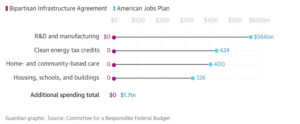The Committee for a Responsible Federal Budget (source image below) has been tracking the amount spent so far fighting Covid, we know that Trillions of dollars of spending have already been allocated to fighting both the coronavirus and the economic impacts of the shutdown, trillions have been spent and trillions more still have been allocated thus far. However, President Biden wants to add an additional $3.5 Trillion in stimulus on top of what has already been spent to boost employment, but a bipartisan compromise bill is being debated in congress that could instead reallocate already promised funds towards infrastructure development which would pose far less risk of inflation.
![]()
There are significant differences between the scope and amount of spending in each plan.
Here’s what the Bipartisan compromise takes out and what it leaves in according to reporting from the Guardian.


The compromise leaves out much the more progressive goals from the Biden administration’s original plan, some of which are arguably not infrastructure.

Tuesday Morning the Senate voted 69-30 to pass the compromise bill through the chamber for $1 Trillion in infrastructure spending. Senate minority leader Mitch McConnell rallied 19 republican Senators including himself to get over the 60 votes required to override a filibuster, so the bill easily passed. The ball is now in congress’s court, but speaker Pelosi has said that she will not bring the bipartisan compromise for a floor vote until the broader budget bill, including the $3.5 Trillion proposed budget reconciliation, also passes the senate. Senate Majority Leader Chuck Schumer expects senate committees to complete their draft of the bill by September 15th, giving congress very little time to increase the federal borrowing limit and approve spending for fiscal 2022. The full $3.5 Trillion stimulus package is a separate budget reconciliation unlikely to receive any republican support. The $1 Trillion bipartisan bill would be largely funded through repurposed unspent covid aid, and spending cuts in other areas, as opposed to the more ambitious $3.5 Trillion infrastructure spending plan which requires a tax hike on large corporations and the wealthy to cover the costs of implementing. The $3.5 Trillion package is also broader in its scope than infrastructure spending alone, the larger bill includes funds to fight against climate change, pay for paid family and maternity leave, childcare, eldercare and funds to fulfill other progressive campaign promises as well so the new president can kill as many birds with one stone as possible. However, passage in the senate does not necessarily mean passage in the house, and the two chambers must agree to harmonize their versions of the bill before it comes across the president’s desk.
From Politico: While Senate passage of the bipartisan infrastructure bill is imminent, the legislation still faces an uncertain future in the House. Democratic moderates are already pressuring Speaker Nancy Pelosi to take the legislation up immediately, though Pelosi and many progressives want to wait until a Democratic-only social spending bill also passes the Senate. That bill cannot be filibustered by Senate Republicans in the evenly split chamber. Pelosi and Schumer have devised a two-track process to enact as much of Biden’s domestic agenda as possible, pledging that the bipartisan infrastructure bill will only advance if it is married to the party-line legislation that will spend as much as $3.5 trillion on climate change action, paid leave policies and health care expansion. The Senate will immediately proceed to a budget setting up that massive bill on filibuster-proof ground after it completes its work on the bipartisan infrastructure bill. Schumer is also considering forcing votes on more elections legislation after Democrats’ sweeping overhaul plan failed in June.
Even if all goes according to plan the senate will be on recess until mid-September. There is a strong sense that the compromise infrastructure spending bill is passable, however it is entirely possible for the $1 Trillion bipartisan deal to die in the house due to a simultaneous lack of support from extremely conservative republicans and extremely progressive democrats, unintentionally teaming up to kill the bill. Speaker Pelosi has insisted that both the bills be passed together in an all or nothing package to appease progressive democrats to guarantee passage in the house, which could make all 18 republican senators that had voted in favor of the original compromise opt for nothing. The $3.5 Trillion stimulus bill is being sent through the senate as a budget reconciliation which would only require a simple 51 vote majority, rather than 60 votes needed to avoid filibuster, so if all 50 democrats stand together (VP Kamala Harris would cast the tiebreaking 51st vote) the full infrastructure spending bill will pass. That said not all 50 democrats may vote for such an ambitious spending bill, there are 4 democratic senators very prominently representing red and purple states, Joe Manchin, in West Virginia, Jon Tester, in Montana, Sherrod Brown, in Ohio, and Krysten Sinema, in Arizona. If even one of these senators defects, then the bill will die in the senate. According to 538.com’s senatorial vote tracker, as of July 30th all 4 moderate democratic senators have voted in line with the President’s position in near lockstep so far during his administration, with Jon Tester Voting 97% in line with President Biden’s position and the other 3 senators voting 100% in line with the president’s stated positions. We know that Joe Manchin spoke positively in favor of the compromise bill saying recently “America has not seen this type of infrastructure investment in 30 years.” It is unknown if he would feel the same way about the larger $3.5 Trillion bill, Senator Manchin has raised concerns about the cost warning of “grave consequences” for the national debt, while Senator Krysten Sinema has directly stated that the bill costs too much.
From Senator Sinema’s statement in July: “I have also made clear that while I will support beginning this process, I do not support a bill that costs $3.5 trillion — and in the coming months, I will work in good faith to develop this legislation with my colleagues and the administration to strengthen Arizona’s economy and help Arizona’s everyday families get ahead,”
Although the compromise removes many progressive goals it still includes an amendment that would require the secretary of transportation to conduct a study on the costs of highway use by different types of drivers, the last time a study was conducted was 1997. There will also be a pilot program, outlined in section 13002 of the bill, that would charge drivers a fee for every mile traveled, according to fox business. The federal gas tax has been at 18.4 cents per gallon since 1993 and has not been adjusted for inflation. Some support a new method of collecting taxes to fund infrastructure, even with an increase in the gas tax cars are becoming more efficient, paying less gas taxes per mile, and people switching to electric vehicles are not paying any gas taxes at all, the gas tax could soon be an outdated method of paying for infrastructure maintenance. However I am reminded that the spark for the yellow vest protests in France was a punitive gas tax increase to encourage people to switch to driving either more efficient gas powered, or electric cars, this tax fell disproportionately on the rural working class and left many upset, likewise an increase in the gas tax (something president Biden promised he wouldn’t do) or a car mileage tax, both would fall disproportionately on the rural working class, and may spark outrage.
From NPR
Lawmakers set aside the largest share of the money, $110 billion, for roads and bridges.
The infrastructure bill also includes roughly:
- $73 billion for electric grid and power infrastructure
- $66 billion for passenger and freight rail
- $65 billion for broadband investments
- $55 billion for water systems and infrastructure
- $50 billion for Western water storage
- $39 billion for public transit
- $25 billion for airports
- $21 billion for environmental remediation projects
- $17 billion for ports and waterways
- $15 billion for electric vehicles
- $11 billion for road safety
Taken from whitehouse.gov
Proposed Financing Sources for New Investment
- Reduce the IRS tax gap
- Unemployment insurance program integrity
- Redirect unused unemployment insurance relief funds
- Repurpose unused relief funds from 2020 emergency relief legislation
- State and local investment in broadband infrastructure
- Allow states to sell or purchase unused toll credits for infrastructure
- Extend expiring customs user fees
- Reinstate Superfund fees for chemicals
- 5G spectrum auction proceeds
- Extend mandatory sequester
- Strategic petroleum reserve sale
- Public-private partnerships, private activity bonds, direct pay bonds and asset recycling for infrastructure investment
- Macroeconomic impact of infrastructure investment (which is to say the bill would partially pay for itself through economic growth)
But will the spending package cause inflation?
According to a report from Moody’s Analytics last month, the Biden spending plan, the original $3.5 Trillion plan represents minimal risk of inflation. But according to Fox Business, Core personal consumption expenditures, the Federal Reserve’s preferred inflation measure, rose 3.4% annually in May, the fastest monthly increase in this metric since April 1992. Fed Chairman Jerome Powell in a recent interview stated the prices are falling and returning to normal levels, he pointed to the price of lumber as an example, lumber is down roughly 60% from its highest point on May 7th, prices in some areas are returning to “normal” levels, so fears of rampant inflation may not be as warranted as the spending may have us assume.


